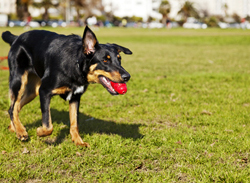Beaucerons are large dogs with short hair. Their black and tan coat comes in many variations, and their bodies are well muscled without being clumsy or heavy. The outer coat is dense and coarse and lies close to the body, while the undercoat is fine, downy, and dense and is gray in color. Beauceron dogs have high ears and oval-shaped eyes. They stand 24 to 27.5 inches at the shoulder and weigh 80 to 110 pounds. With proper care, the breed can live up to 12 years.
These dogs have very high exercise needs and are intelligent and strong-willed.
Beautiful, gentle, and faithful dogs, Beaucerons are great companion animals but might not be the best choice for first-time dog owners. These dogs have very high exercise needs and are intelligent and strong-willed.
In France, this breed is called the Berger de Beauce, which means "shepherd of the Beauce." La Beauce is the area surrounding Paris.
A gentle and faithful breed, Beaucerons make loving companion animals. They are reserved with strangers, but not timid, and are loyal and protective of their family. These dogs are confident, independent, and strong-willed, traits that make people assume they'll be difficult to manage or train. Nothing is farther from the truth, however; Beaucerons are rarely much trouble and are highly trainable.
Due to their size and activity needs, these might not be the best choice for families who live in apartments or condominiums. Beaucerons are playful and are okay with older children, but they have some trouble getting along with cats and other dogs.
Beaucerons are happiest when given a task to complete, and they enjoy search and rescue games, obedience, flyball, agility, herding, and tracking. These dogs are very high energy and need a family that regularly engages in bicycling, running, hiking, and other activities. The Beauceron loves to accompany his family on these adventures. Although this breed is athletic and likes to be outside, these dogs also need time with their human companions.
In general, Beaucerons are a very healthy breed. They are not at risk of any concerning genetic diseases, although there's never a guarantee that any puppy purchased or adopted will be completely healthy.
This breed is prone to allergies and a few other disorders that may come and go throughout life. Beaucerons are also more likely than other dog breeds to develop dermatomyositis, which is an inflammatory condition that affects the muscles, skin, fat, and blood vessels. There is no cure for dermatomyositis, but there are treatments available to minimize symptoms. Beaucerons are also at increased risk for hip dysplasia and gastric torsion, a potentially fatal condition that requires surgical correction.
With regular veterinary checkups, routine vaccinations, a healthy diet, and daily exercise, Beauceron dogs can live 10 to 12 years.
Beaucerons are very intelligent, eager to learn, obedient, and highly trainable dogs. They can be very assertive and therefore need a human companion with a firm hand. With early training and socialization, barking and other common issues are rarely problematic. Positive reinforcement works especially well with this breed.
These dogs are very territorial and wary of strangers, which makes them ideal watchdogs. Without socialization, however, they may have trouble knowing when to relax and when to protect their family. This trait also shows itself around other dogs; Beaucerons may show aggression toward unknown dogs, especially if they feel their family or property is threatened.
Beaucerons have very high exercise needs and are known to chase small animals. These dogs may also chase or nip at children due to their herding instincts, but this behavior cannot be tolerated. Offer Beaucerons plenty of chew toys, or else they'll make their own, and make sure they have time both inside and outside to play. Without mental and physical stimulation, this breed will become bored and destructive. Keep these dogs securely fenced; an underground, electric system will not contain them.
Brush the Beauceron's coat weekly to remove dead hair and distribute skin oils. This breed sheds a small amount year-round and more during the spring and fall. During shedding seasons, more frequent brushing is generally sufficient to keep hair off furniture and clothing. Use a rubber hound mitt or natural bristle brush for best results.
Beaucerons are prone to allergies and may have greater difficulty with shampoos and soaps than some other breeds. Bathe every few months with a hypoallergenic shampoo designed specifically for use on dogs. These shampoos are pH balanced to be as gentle as possible. Consult a veterinarian, if necessary.
The nails require trimming infrequently, and the teeth should be brushed at least several times each week to promote fresh breath and prevent tooth decay and gum disease. Check the ears weekly for signs of infection or other problems. Clean waxy or dirty ears promptly to prevent skin irritation and infections.
Beaucerons are a very old breed in France, although these dogs are not well known outside of that country. They are the preferred sheep-herding dog in France.
The earliest records regarding the Beauceron breed date back to a Renaissance manuscript of 1578. Originally, these dogs were bred for their exceptional herding abilities, and they were used to guard large flocks of sheep. Beaucerons also herded cattle and guarded homes. Because the breed needed to move hundreds of heads up to 50 miles without succumbing to exhaustion, breeding focused on endurance and structure.
In more recent times, these dogs worked as police dogs or served alongside humans in both world wars as mine detectors, messenger dogs, and trail finders. Beaucerons still perform this type of work today.
The American Kennel Club officially recognized the Beauceron in 2007.

